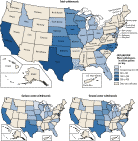
 |
Estimated Use of Water in the United States in 2000
Livestock
In the 1990 and 1995 USGS water-use Circulars (Solley and others, 1993, 1998, respectively), the livestock category was split into the subcategories of livestock and animal specialties as specified in the 1987 Standard Industrial Classification manual (Office of Management and Budget, 1987). In the 1990 and 1995 Circulars, withdrawals for fish farms and watering horses were included in animal specialties; withdrawals for fish hatcheries were included in the commercial category. For 2000, the livestock category includes the types of animals formerly included in animal specialties. Fish farms and fish hatcheries comprised the aquaculture category for 2000.
For 2000, the estimate of livestock water use for the United States was based on estimates of total freshwater withdrawals for livestock in 22 States, rather than on estimates from all States. These 22 States included the 10 States with the largest withdrawals for the livestock subcategory during 1995, and 12 other States in which livestock water-use data were collected as part of a broader State water-use program. The 22 States reporting for 2000 accounted for 75 percent of the livestock subcategory water use during 1995. During 1995, water withdrawals for the livestock subcategory accounted for a small percentage of the total, less than 1 percent of the total water withdrawals for all categories.
Livestock withdrawals for 2000 are listed by State in table 8.![]() During 2000, withdrawals were an estimated 1,760 Mgal/d, or 1,980 thousand acre-feet per year. Livestock withdrawals were less than 1 percent of total freshwater withdrawals and nearly 1 percent of total freshwater withdrawals for all categories excluding thermoelectric power. Ground water was the source for 58 percent of total livestock withdrawals. Total withdrawals for livestock increased slightly for the 22 States that reported data for both 1995 and 2000. However, withdrawals actually increased only in 8 of the 22 reporting States.
During 2000, withdrawals were an estimated 1,760 Mgal/d, or 1,980 thousand acre-feet per year. Livestock withdrawals were less than 1 percent of total freshwater withdrawals and nearly 1 percent of total freshwater withdrawals for all categories excluding thermoelectric power. Ground water was the source for 58 percent of total livestock withdrawals. Total withdrawals for livestock increased slightly for the 22 States that reported data for both 1995 and 2000. However, withdrawals actually increased only in 8 of the 22 reporting States.
The geographic distribution of total, surface-water, and ground-water withdrawals for livestock is shown in figure 8.
 California, Texas, and Oklahoma accounted for 49 percent of total livestock withdrawals for States that reported for 2000. California, Texas, North Carolina, and Kansas accounted for nearly one-half of ground-water withdrawals. California, Texas, and Oklahoma accounted for two-thirds of surface-water withdrawals. The areas of major water withdrawals for livestock (as shown in figure 8), for the most part, correspond to the major areas where corn, hay, and alfalfa are grown. For example, the major hog- and pig-producing States of Iowa, Minnesota, and Illinois also are major corn-growing States; the major cattle- and calf-producing States of Texas, Kansas, and Nebraska also are major hay and alfalfa growing States (U.S. Department of Agriculture, May 1999).
California, Texas, and Oklahoma accounted for 49 percent of total livestock withdrawals for States that reported for 2000. California, Texas, North Carolina, and Kansas accounted for nearly one-half of ground-water withdrawals. California, Texas, and Oklahoma accounted for two-thirds of surface-water withdrawals. The areas of major water withdrawals for livestock (as shown in figure 8), for the most part, correspond to the major areas where corn, hay, and alfalfa are grown. For example, the major hog- and pig-producing States of Iowa, Minnesota, and Illinois also are major corn-growing States; the major cattle- and calf-producing States of Texas, Kansas, and Nebraska also are major hay and alfalfa growing States (U.S. Department of Agriculture, May 1999).
Few State agencies require livestock operations to report water withdrawals; therefore, most estimates of withdrawals for livestock typically were derived using animal population counts (most often from the USDA National Agricultural Statistics Service) and a coefficient for gallons of water per animal per day. Coefficients vary by State and, for most States, were provided by agricultural extension agents or water-permitting agencies. Coefficients may reflect both the effect of climate on animal watering and facility maintenance needs.
Water Use in the United States | USGS Water Resources of the United States
For more information: wu-info@usgs.gov